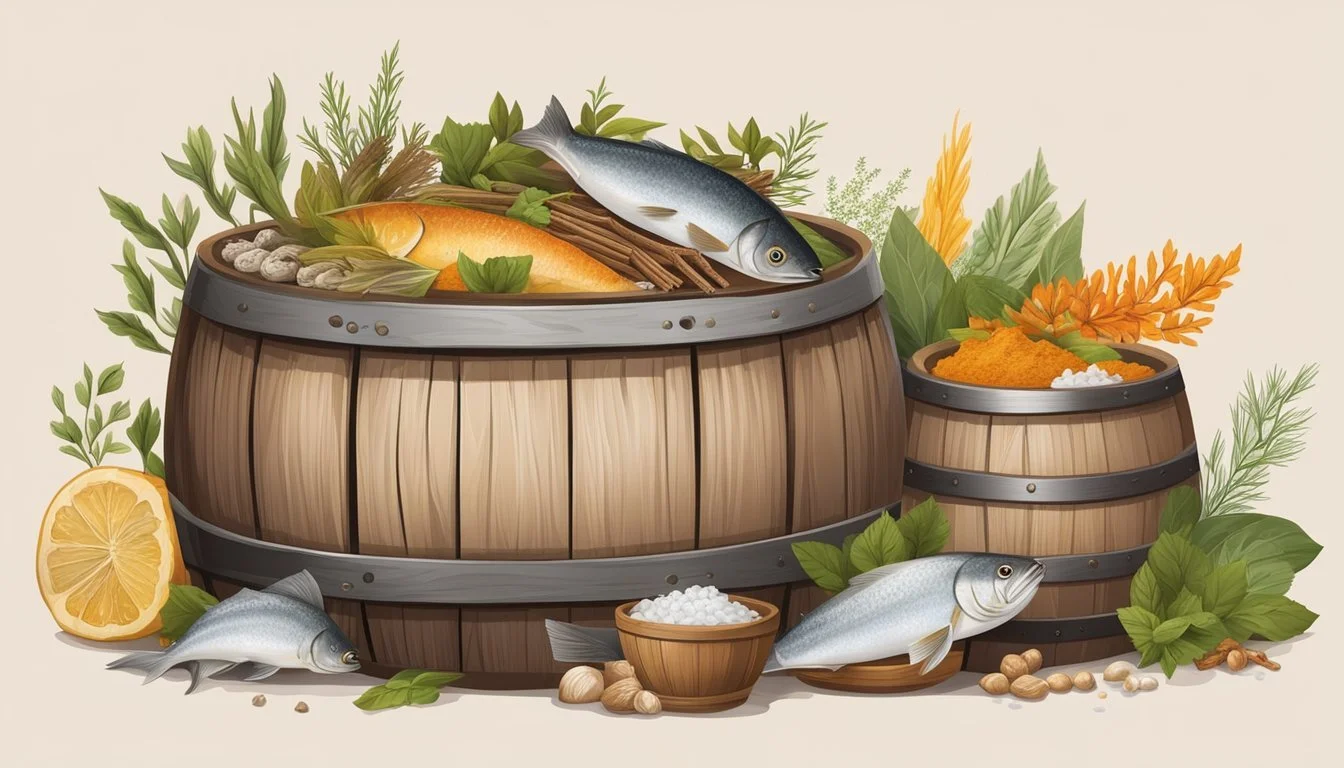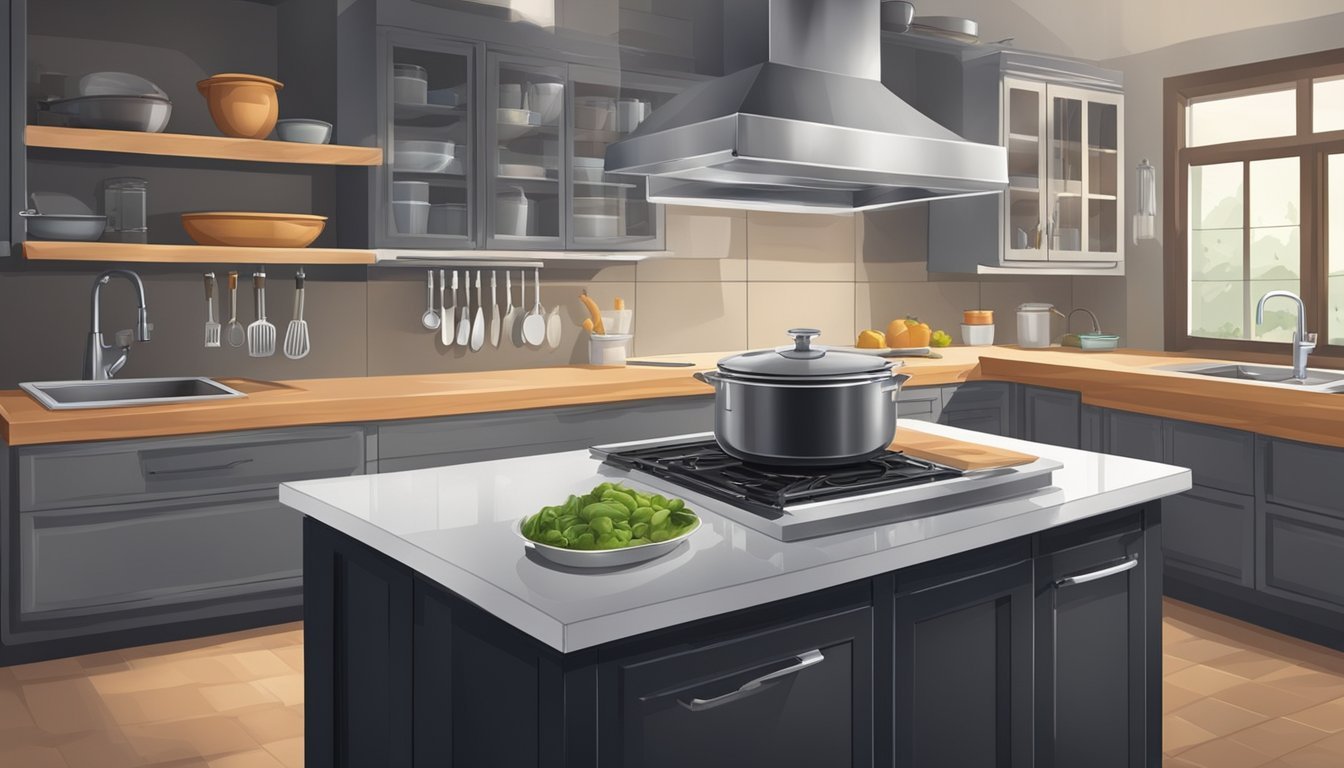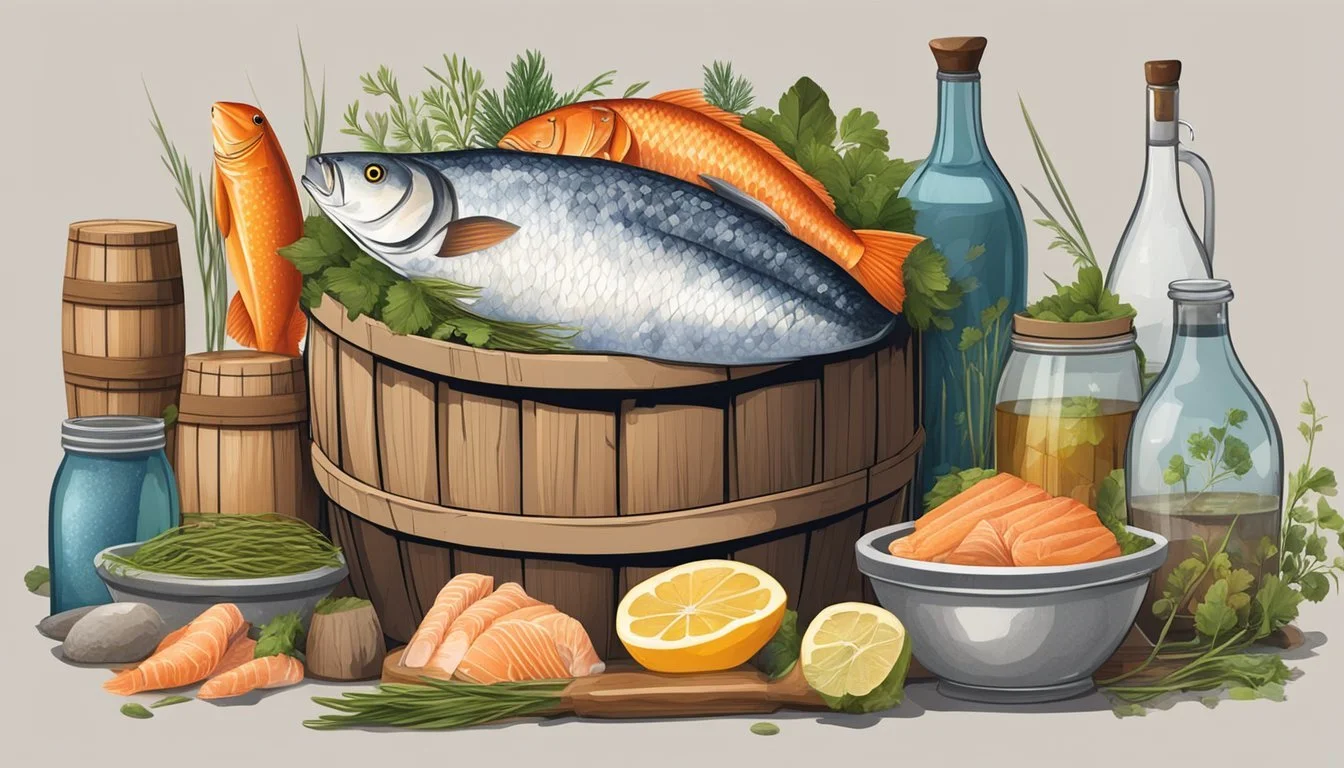How to Ferment Rakfisk
The Ultimate Guide to Norwegian Fermented Fish
Rakfisk is a traditional Norwegian delicacy dating back centuries, highlighting the preservation techniques of Nordic cuisine. The specialty involves fermenting trout or char, with a process that sets it apart in flavor and texture from other preserved fish. The meticulous fermentation imbues rakfisk with a distinct tangy, salty taste and a notable pungent aroma that is cherished within Norwegian food culture.
The fermentation process of rakfisk requires precision in temperature control and salting ratios to achieve the desired outcome. Salt is a crucial component in preserving the fish and aiding the fermentation, while the temperature must be carefully monitored, not exceeding 8ºC (46ºF), to ensure a safe and successful curing process. The technique is often compared to that of wine-making due to the attention to detail and the patience required as the fish ferments over several weeks or up to a year.
Enjoying rakfisk is an experience that incorporates both taste and tradition, often served with accompaniments like sour cream, red onion, and flatbread, which complement its strong flavor profile. Through careful selection of quality fish and adherence to tried-and-tested methods, one can prepare rakfisk at home, partaking in a culinary custom that has been a staple in Norway for generations.
History and Tradition of Rakfisk
Rakfisk is deeply embedded in Norwegian food culture, representing a culinary heritage that dates back centuries. This traditional Norwegian dish is more than a gastronomic preference; it is a celebration of Norway's history and culture.
Norwegian Cuisine Heritage
Rakfisk's origins are found in the need for preserving fish in the days before refrigeration. This method of fermentation has been part of Norwegian culture since it allowed inhabitants to store food through harsh winters. The process of making rakfisk involves salting trout or char and fermenting it under controlled conditions. The ideal temperature for fermentation is a steady max of 8ºC / 46ºF, traditionally maintained in the cold climates of Norway. Fermentation can last several months, contributing to the dish's potent flavor profile.
Key Components of Rakfisk Preparation:
Fish: Trout or Char
Salt: Approximately 6% of fish weight
Temperature: Max of 8ºC / 46ºF
Fermentation Duration: 6 weeks to a year
Rakfisk Festival Highlights
Every year, the Valdres region in Norway becomes the epicenter of the Rakfisk Festival, attracting enthusiasts keen on celebrating this unique aspect of Norwegian gastronomy. The festival reflects the community's pride in their traditional dish and offers a glimpse into the significance of rakfisk in Norwegian culture. Attendees sample various rakfisk preparations, partake in competitions, and immerse themselves in cultural activities that underscore the dish's historical importance. It's a vibrant display of Norway's food heritage and a testament to the dish's survival and adaptation through the ages.
Selecting and Preparing the Fish
For a successful rakfisk fermentation, choosing the highest quality trout and following a meticulous cleaning and salting process are essential. The integrity of the proteins and fat within the fish will determine the final taste and safety of rakfisk.
Choosing the Right Trout
Selecting the correct species of freshwater fish is critical for rakfisk. Traditionally, trout or char is used due to their suitable fat content and firm flesh. The fish must be fresh, ideally caught the same day, to minimize the risk of spoilage. Fat content is important; it should be moderate to high to ensure rich flavor post-fermentation.
Cleaning and Curing Process
Once chosen, the trout undergoes a thorough cleaning process. The fish must be gutted, scaled, and rinsed with care to remove all debris and blood. The cleanliness of the trout is crucial to avoid harmful bacteria influencing the curing process, which could render the rakfisk unsafe for consumption.
Salting and Weight Application
Lay trout out in a suitable container, typically glass or food-grade plastic
Cover uniformly with coarse sea salt; use around 6-10% of the fish's weight
Place another layer of trout, repeat salting
Apply weight to the fish to assist the curing process and expel any air
The application of salt, specifically coarse sea salt, is not just for flavor—it acts as a preservative, inhibiting undesirable bacteria while allowing beneficial lactic acid bacteria to thrive. Following the salting, weights are applied to the fish to ensure even contact with the salt and to help extrude water, which is an essential part of the curing process.
The Fermentation Process
Fermenting rakfisk involves precise temperature control and careful monitoring over a period to ensure proper flavor development and food safety.
Optimizing Fermentation Conditions
For rakfisk, the ideal fermentation temperature is at or below 8°C (46°F). To initiate the fermentation process, one must prepare a brine solution typically consisting of 6% sea salt and water. The fish, commonly trout or char, should be gutted, scaled, and cleaned thoroughly to prevent unwanted bacterial growth. They are then placed in an airtight container with the brine, which creates an anaerobic environment conducive for the fermentation process to occur. Notably, the ratio of salt to water in the brine and the maintenance of the pH level are critical to inhibit harmful bacteria and to activate the desired enzymes responsible for breaking down the fish's proteins into amino acids.
Table: Rakfisk Brine Composition
Sea Salt: 6%
Water: 94%
Note: Adjustments to the brine's concentration may be necessary depending on the fish used and desired final taste.
Monitoring the Fermentation Period
Throughout the fermentation period, which can span from several weeks to a year, regular observation is necessary. One should check the fish for any signs of spoilage, unusual odors, or textures. Temperature plays an essential role during this period, and it is imperative to consistently maintain it within the optimal range to ensure a successful fermentation process. Additionally, the development of the flavor profile is heavily dependent on the formation of lactic acid through the enzymatic reactions, requiring a stable and suitable pH level. Utilizing tools like a thermometer and pH meter can assist in maintaining these conditions over the fermentation period.
Key Points to Monitor:
Temperature: Keep below 8°C (46°F).
pH Level: Monitor to ensure it remains in a range that prevents harmful bacterial growth.
Visual and olfactory inspection: Look for any signs of spoilage and assess the smell.
At the conclusion of the fermentation period, rakfisk should have achieved its characteristic tangy, salty flavor and be ready for consumption, typically alongside traditional Norwegian accompaniments.
Serving Rakfisk
When serving Rakfisk, the emphasis is on balancing its unique flavor with a variety of traditional and contemporary accompaniments. It's important to complement the fish's tangy and salty nuances with garnishes that enhance rather than overpower the delicate fermented taste.
Traditional Accompaniments
Rakfisk is traditionally served with a set of specific accompaniments that are designed to harmonize with the fish's pungent aroma and flavor. These include:
Flatbreads: Typically, Rakfisk is served with lefse (a soft Norwegian flatbread) or lomper (potato flatbread).
Potatoes: Boiled potatoes are a common pairing, providing a neutral taste that balances the saltiness.
Toppings: A variety of toppings such as finely chopped onions, (What wine goes well with onions?) dollops of sour cream, and occasionally butter, are added to taste.
Beverages: It is often accompanied by Norwegian spirits like aquavit or beer, which are believed to complement the strong taste of the fish.
Contemporary Serving Suggestions
While Rakfisk is steeped in tradition, contemporary serving suggestions include:
Gourmet Twists: Updating the traditional pairings with gourmet variants, such as using herbed sour cream or caramelized onions.
Salad Inclusion: Incorporating Rakfisk into a salad for a lighter option, dressed with a mustard or citrus vinaigrette to cut through the fermented flavor.
Creative Flatbreads: Experimenting with different types of flatbread, integrating whole grains or seeds for a modern twist.
By understanding these serving traditions and suggestions, enjoyers of Rakfisk can experience both the authentic flavors and inventive variations of this distinctive Norwegian delicacy.
Health and Safety Considerations
When fermenting rakfisk, prioritizing health and safety is crucial to avoid foodborne illness. Proper hygiene and an understanding of fermentation risks are essential. Ensuring the final product is both safe to eat and enjoyable involves careful attention to the process and the environment in which it occurs.
Importance of Hygiene
Hygiene plays a pivotal role in the fermentation of rakfisk. The process should begin with thoroughly cleaned equipment to prevent the introduction of harmful bacteria. All surfaces that come into contact with the fish must be sanitized, including cutting boards, knives, and fermentation vessels.
Fish Preparation: Ensure the fish is gutted and rinsed with care, reducing the opportunity for contaminants.
Utensils and Equipment: All tools should be thoroughly cleaned and preferably sterilized before use.
Hands: Wash hands regularly with antibacterial soap, especially after handling the fish or fermentation vessel.
Maintaining a clean environment limits the growth of unwanted bacteria that can produce unpleasant odors or potentially dangerous toxins. The characteristic smell of rakfisk is partly due to compounds such as hydrogen sulfide and butyric acid, which are natural byproducts of fermentation and should not be overly strong if the process is conducted correctly.
Understanding Fermentation Risks
The fermenting process of rakfisk involves inherent risks that must be managed to ensure a safe product. Proper salting and temperature control are key to fostering the right conditions for lactic acid bacteria to thrive and to inhibit the growth of pathogenic microorganisms.
Salting: Use the correct proportion of salt to fish, often about 6-10%, to ensure the proper preservation environment.
Temperature: Maintain an ideal temperature around 8ºC (46ºF) throughout the fermentation process to prevent the proliferation of harmful bacteria.
Duration: Fermentation time can vary. A longer period can intensify the flavor but also increases the risk of high levels of biogenic amines.
The fish should be rich in nutrients and fatty acids, without the growth of harmful bacteria. It's important to be aware of the signs of spoilage, which include an excessively strong or foul aroma, indicating that the fish may not be safe to consume. Proper fermentation should not result in an overwhelming hydrogen sulfide smell. Instead, it should have a strong but not unpleasant aroma, indicative of well-fermented rakfisk.
Culinary Techniques and Recipes
This section dives into the methods for creating homemade Rakfisk, a staple in Norwegian cuisine, and explores various recipe variations that accentuate this unique dish.
Preparing Homemade Rakfisk
To start the preparation of Rakfisk, one begins with trout or another freshwater fish, gutted and rinsed. The fish are then layered in a clean container, alternating with generous amounts of salt, typically using a ratio of 6-10% salt to the weight of the fish. It is crucial to maintain a controlled environment with a temperature not exceeding 8ºC (46ºF) to ensure proper fermentation.
Ingredients for Homemade Rakfisk:
Fresh trout or other freshwater fish, gutted and cleaned
Salt (6-10% of the weight of the fish)
Steps:
Layer the cleaned fish and salt in a container.
Apply pressure using a weighted lid to compress the fish.
Store the container at a constant temperature, ideally around 6ºC (43ºF).
Allow the fish to ferment for at least 6 weeks, adjusting the time to modify the flavor intensity.
By adhering to tradition, one can create a spreadable and flavorful culinary experience that embodies the essence of Norwegian cuisine.
Variations in Rakfisk Recipes
While the fundamental method for preparing Rakfisk is consistent, aficionados of this culinary tradition often experiment with additions to enhance the flavor profile of the dish. Common variations include adding spices such as juniper berries during the fermentation process. Some may adjust the fermentation duration for a milder or stronger taste. Additionally, serving methods vary, with Rakfisk commonly being enjoyed on flatbread or lefse, accompanied by sour cream, thinly sliced red onion, and sometimes mustard or potatoes.
Common Additions:
Juniper berries
Mustard
Thinly sliced red onion
Sour cream
Adapting the recipe allows one to appreciate the versatility of Rakfisk and its ability to be tailored to personal palates, while still respecting the foundations of this centuries-old Norwegian tradition.
Cultural Significance
Rakfisk holds a prominent place in Norwegian culture, reflecting the deep historical roots of traditional gastronomy and the festive customs that bring communities together.
Rakfisk in Norwegian Gastronomy
Rakfisk is more than a dish; it's an integral part of Norwegian food culture, showcasing the preservation techniques developed in the cold climates of Norway. Originating from Valdres, this delicacy made from fermented fish, most commonly trout, has been savored for centuries. It stands as a testament to the ingenuity and endurance of traditional Norwegian culinary practices. Typically enjoyed during Christmastime, rakfisk is often accompanied by lefse (a traditional flatbread), sour cream, onion, and aquavit, a spirit that complements the fish's robust flavor.
Festivals and Celebratory Customs
Rakfisk festivals, particularly in the town of Fagernes, underscore its cultural significance. The annual event is a celebration of this unique Norwegian dish, attracting enthusiasts eager to share in the tradition and locals proud of their heritage. Rakfisk frequently graces the table at various Norwegian celebrations, tying modern-day festivities back to ancestral Norwegian culture and traditions. Even in the capital city of Oslo, one can find traces of the rakfisk legacy, as it has carved its niche in the national palate and continues to be a symbol of Norway's rich and flavorful history.
Pairings and Drink Recommendations
When enjoying rakfisk, the right beverages can enhance the culinary experience. Optimal pairings add balance to the strong flavors characteristic of this traditional Norwegian dish.
Selecting the Right Beverages
Aquavit is a staple spirit in Norwegian cuisine and pairs exceptionally well with rakfisk. It complements the fermented fish with its distinct caraway or dill flavorings. Beers, especially those that are light and crisp, can also be an excellent choice to offset the robust nature of rakfisk.
Aquavit: Norwegian Linie Aquavit, served chilled
Beer: Pilsners or wheat beers, served cold
Traditional and Modern Pairings
Traditionally, rakfisk is served with flatbreads, potatoes, sour cream, and red onions. Sophisticated palates may explore modern pairings that include a variety of artisanal breads and condiments. Understanding the balance and contrast in flavors is key to creating a harmonious culinary experience.
Traditional:
Flatbread or lefse
Boiled potatoes
Sour cream
Finely sliced red onion
Modern twists:
Rye or sourdough bread
Pickled vegetables (What wine goes well with pickled vegetables?)
Mustard sauce
When planning the raking experience, consider these recommendations to enrich the sensory journey of tasting rakfisk.








